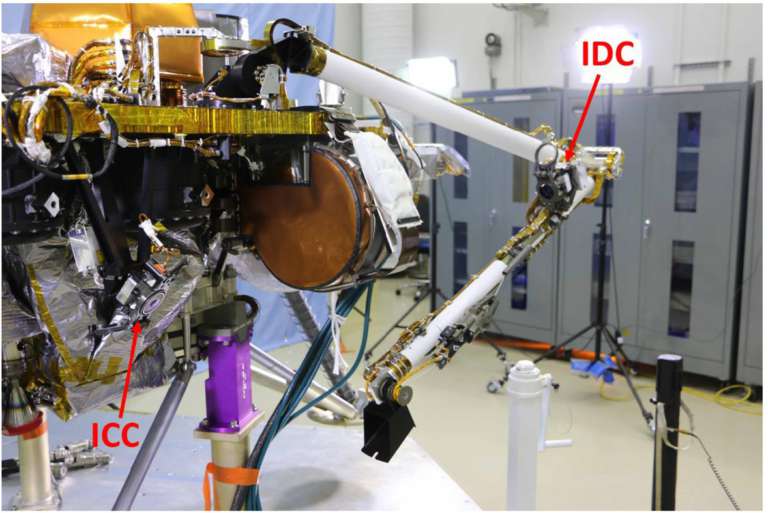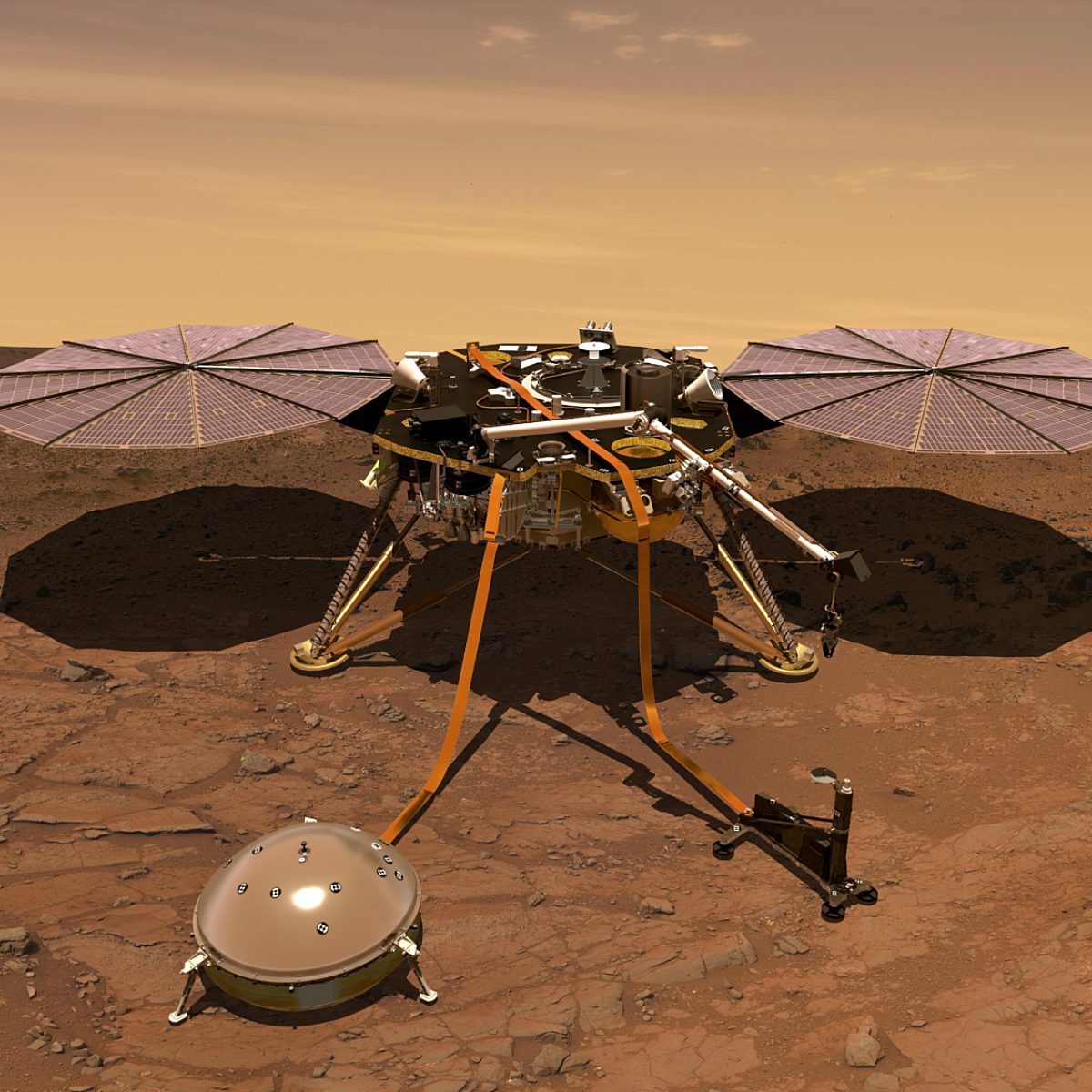Emily Lakdawalla • Feb 20, 2019
InSight update, sols 43-83: Instrument placement complete
Time to launch the subterranean probe
InSight has placed its second science instrument on the ground and set it free.

Now that InSight has finished placing both science instruments and the wind cover, the arm’s required work is done and the science team can set about commissioning their instruments. For the heat probe instrument, commissioning involves driving its instrumented “mole” as many as 5 meters into the ground beneath the landing site, a process that will take a minimum of 40 days. How does the heat probe’s mole work? Why does it take so long to place it? And what happens if the InSight mole hits a rock? I have answers to these questions for you, with some help from deputy principal investigator Sue Smrekar. And then I’ll tell you about future plans for the arm.
InSight, NASA's Mars lander that studied the planet's interior
InSight was a Mars lander studying the red planet's interior to learn how other worlds are made.
First, one piece of news -- or non-news: No Marsquakes have been detected yet. Smrekar said they’re starting to understand what they’re seeing from the seismometer -- they’ve tuned it to the point where they can start to hear the background noises of the atmosphere. In order to remove the effects of the atmosphere from the seismic data, they need to measure the weather. Yesterday the mission announced a live-ish weather report from Mars, reporting data from InSight’s meteorology instruments. I say live-ish because InSight doesn’t continuously broadcast these measurements to Earth; sometimes it may be 3 days before we receive the data InSight has taken. But once NASA has the data, they’ll post it.
Okay, let me now introduce you to InSight's Heat Flow and Physical Properties Probe.
Heat Flow and Physical Properties Probe (HP3)
The HP3 instrument has a support structure that sits on the surface. The cylinder at the front of the structure contains HP3’s self-hammering mole.

The mole is a spike 2.7 centimeters wide and 40 centimeters long. It will hammer itself into the ground, pulling behind it an instrumented tether. Here’s a nice video explainer from DLR about that process. The parts specific to instrument placement begin 1 minute in, and at 1:45 there’s a really nice animation of the cam-and-roller device that produces the self-hammering action.
Video explainer on InSight's HP3 instrument Video: DLR
The tether isn’t just a cable. It carries 14 temperature sensors, spaced on average 35 centimeters apart (though the ones closer to the mole are spaced closer together).
Placing the Probe
While working to bury the probe, HP3 will be performing an experiment to measure the thermal conductivity of the soil. “Thermal conductivity” describes how quickly a material conducts heat. Metal is a material with high thermal conductivity, as anyone who’s left a metal spoon in a boiling pot for just a minute knows. That’s one reason we use wooden spoons when we cook, because wood has much lower thermal conductivity, and we can leave it in a pot without the handle heating too fast. Sand has a low thermal conductivity, similar to wood; porous rock is slightly more conductive; rock is more conductive still, but still much less so than metal. (I used this website to look up thermal conductivities of common materials.)
The mole measures thermal conductivity by heating itself with constant electrical power and measuring how its temperature changes. The mole’s metal skin conducts the heat efficiently to the soil, and the heat will diffuse into the soil faster if the conductivity is high and slower if the conductivity is lower.
To perform a thermal conductivity survey, the mole will spend a sol hammering itself to 50 centimeters depth. Then it will wait two sols for the heat generated by the friction of its motion to dissipate. Then it will spend one sol measuring thermal conductivity, heating up and then waiting for the heat to dissipate. This 4-sol process has to be repeated 10 times for the mole to reach the target depth of 5 meters, hence the 40-sol minimum. However, any number of things could make the operation take longer, including operational snags, data relay issues, or unexpectedly hard ground. InSight usually operates within a 4-hour window each sol when the spacecraft is warmest; if the mole doesn’t get to 50 centimeters in those 4 hours, it will continue to try to hit the target depth on the next sol.

What Happens if the InSight Mole Hits a Rock?
This is the second most common question I get asked about the InSight mission. (The most common is: how can you take a sensitive instrument like a seismometer, launch it on a rocket, land it on Mars, and expect it to work? I’m happy that question is now obsolete.)
Don’t worry, HP3’s designers have thought about this. The following are the reasons why they’re not overly concerned:
The mole can push aside small rocks. We have dug in Mars soil many, many times before, both with scoops (Viking and Phoenix) and wheels (Sojourner, Spirit, Opportunity, and Curiosity), and scientists have written quite a lot about the properties of various types of Mars soil. The mole has been designed to deal with a range of potential Mars soil properties, and can hammer itself forcefully enough to be able to push aside pebbles and rocks up to 5 or 10 centimeters across that it encounters as it penetrates.
The mole can skitter around larger rocks. If the pointy tip of the mole encounters a rock that is too large to push aside, it will most likely encounter a surface that is not horizontal. In that case, the hammering action will cause the tip of the mole to be deflected, sliding it down the sloping face and around the rock; once it’s detoured around the rock, the mole will right itself and continue driving vertically. The mole contains a tiltmeter that will be monitoring any such deflections so the team will know pretty precisely what the mole’s course into the surface was. The tiltmeter can measure deflections to an accuracy of 1 degree.
Big rocks are not likely. One of the factors that led them to the Elysium landing site was the relative absence of large rocks. The surface of the landing site is less rocky than most previous landing sites, comparable to Phoenix. How about buried rocks? A tricky bit of geomorphology research told them there shouldn’t be many. Here’s how that worked: they mapped the sizes of impact craters and noted whether the craters had blocky ejecta (that is, whether they were surrounded by large rocks that had been dug up during the impact). Larger craters do have blocky ejecta, but smaller craters do not. The transition between small, not-blocky craters and larger, blocky ejecta craters happens at a crater size that would have dug its ejecta from more than 5 meters’ depth. The lack of blocks in these smaller craters suggests that there aren’t big rocks in the top 5 meters or so of soil at Elysium.

But still, what if? What if, despite all these factors, HP3 has the misfortune to encounter a really big, really flat, horizontal rock and the mole does not get to the minimum desired 3 meters depth? It might affect the accuracy with which they could measure the heat flow out of Mars, but they’ll still get a measurement.
Just how deep they need to go depends on the as-yet-unknown thermal conductivity of the soil. For the best-quality measurement, they need to bury the probe deeper than the annual temperature variations reach, to a depth where the temperature is constant year-round. If the thermal conductivity of the soil is high, then the annual variations will penetrate deeper, and so must the probe. Their target depth of at least 3 meters is the mission’s worst-case scenario, for a case with high thermal conductivity and low heat flow. If the thermal conductivity is lower than in the worst-case scenario, then the annual variations won’t get so deep, and the probe will quickly find itself in constant-temperature territory.
The good news is that InSight landed in what looks like an especially sandy spot -- an old crater now filled to the brim with sand. Sand has relatively low thermal conductivity. So signs point to a good result for HP3 even if, for whatever reason, the probe doesn’t get very deep.

What’s Next for the Arm and Camera
I asked Smrekar if the arm needed to be held still for the seismometer and heat probe to work. I’m happy to report that it doesn’t. That means they'll be able to use the arm during the rest of the prime mission, which is important, because InSight aims its camera by moving its arm. There’s a long list of activities that the science team would like to do with the arm and camera, but they are constrained in how much they can do.
A top priority is a complete 360-degree panorama -- ideally, in stereo -- of the landing site. They should be getting that in the next month or so. They’ll also use the cameras to monitor for changes on the surface, look for dust devils, and measure atmospheric opacity. Those are all pretty standard camera operations that they’re prepared to do right away.
Beyond that, there’s not a lot they can do -- yet. InSight has the same restriction that any space mission has: you can’t run an activity on a spacecraft until you’ve demonstrated its safety and efficacy in a testbed on Earth. Up to now, InSight’s testbed (named Foresight) has been fully occupied with the mission’s required activities, rehearsing out the placement of the instruments before the Mars spacecraft places them for real.

Now that both instruments and the wind and thermal shield have been placed, the testbed has time to get to work trying out new activities. A lot of those potential activities involve the scoop, a bit of hardware on the arm that is only there because the canceled Surveyor 2001 mission needed a scoop. InSight has no mission requirement to ever touch that scoop to dirt. But there are lots of scientists on the team who would love to be able to do things like push on the ground to see what its elastic response is; dig a trench to see how the grain size and other visible properties vary with depth; make a pile of dirt and watch to see how quickly it blows away; and so on. They can’t do any of this before they try it out in the testbed; something they’ve had neither time nor resources to do yet. Now they have the time -- do they have the budget? We’ll see. First: a 360-degree panorama, coming soon. I hope they’ll take and downlink those images in time to hang a huge printout of the InSight panorama at the upcoming Lunar and Planetary Science Conference, where there will be a whole session devoted to InSight!
Support our core enterprises
Your support powers our mission to explore worlds, find life, and defend Earth. You make all the difference when you make a gift. Give today!
Donate

 Explore Worlds
Explore Worlds Find Life
Find Life Defend Earth
Defend Earth




